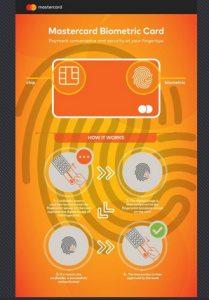South Africa is the first market to test Mastercard’s new next generation biometric card, combining chip technology with fingerprints to verify the cardholder’s identity for in-store purchases.
The demonstration happened two weeks ago at Absa Bank and Pick n Pay, a leading supermarket retailer.
MasterCard has also previously trialed facial biometrics for payments, launching a s”selfie pay” app last October which lets people authenticate an online payment by showing their face to their phone’s camera.
From the official press release:
Mastercard press image
The new card builds on fingerprint scanning technology used for mobile payments today and can be used at EMV terminals worldwide.
“Consumers are increasingly experiencing the convenience and security of biometrics,” said Ajay Bhalla, president, enterprise risk and security, Mastercard. “Whether unlocking a smartphone or shopping online, the fingerprint is helping to deliver additional convenience and security. It’s not something that can be taken or replicated and will help our cardholders get on with their lives knowing their payments are protected.”
How It Works
A cardholder enrolls their card by simply registering with their financial institution. Upon registration, their fingerprint is converted into an encrypted digital template that is stored on the card. The card is now ready to be used at any EMV card terminal globally.
When shopping and paying in-store, the biometric card works like any other chip card. The cardholder simply dips the card into a retailer’s terminal while placing their finger on the embedded sensor. The fingerprint is verified against the template and – if the biometrics match – the cardholder is successfully authenticated and the transaction can then be approved with the card never leaving the consumer’s hand.
Benefits
Authenticating a payment transaction biometrically – in this instance via a fingerprint – confirms in a very unique way that the person using the card is the genuine cardholder.
Merchants can easily maximize the shopping experience delivered to their customers, as the card works with existing EMV card terminal infrastructure and does not require any new hardware or software upgrades.
For issuers, the technology helps detect and prevent fraud, increase approval rates, reduce operational costs and foster customer loyalty. Additionally, a future version of the card will feature contactless technology, adding to the simplicity and convenience at checkout.
Trials Underway
The recent South African trials mobilized employees from Pick n Pay and Absa Bank to test the potential ways convenience and security could contribute to the checkout process. Over the next few months, additional trials will be conducted with the biometric card. A full roll out is expected later this year.
Said Richard van Rensburg, deputy CEO of Pick n Pay: “We are delighted that this innovation has been trialed for the first time at Pick n Pay stores in South Africa. Biometric capability will mean added convenience and enhanced security for our customers. The technology creates a platform on which we can further our strategy of personalizing the shopping experience in a meaningful way. We have been extremely impressed with the robust and secure nature of the technology.”
For Absa, the biometric card forms part of the bank’s strategy to test and develop sophisticated technology capabilities designed to improve its payment operations and client service, reduce risk, and make banking easier and even more secure for its customers.
“We are very proud to be the first bank in Africa to test – in a real payment environment – the single-touch authentication technology that will unlock the benefits of biometrics,” said Geoff Lee, head of card and payments at Absa Retail and Business Banking. “The technology will effectively enable our customers to rely on their unique fingerprints to make payments in a face-to-face environment. Following the test period, we will make it available to our customers in a way that is affordable, reliable, and convenient and, most importantly, extremely secure.”
Additional trials are being planned in Europe and Asia Pacific in the coming months.

